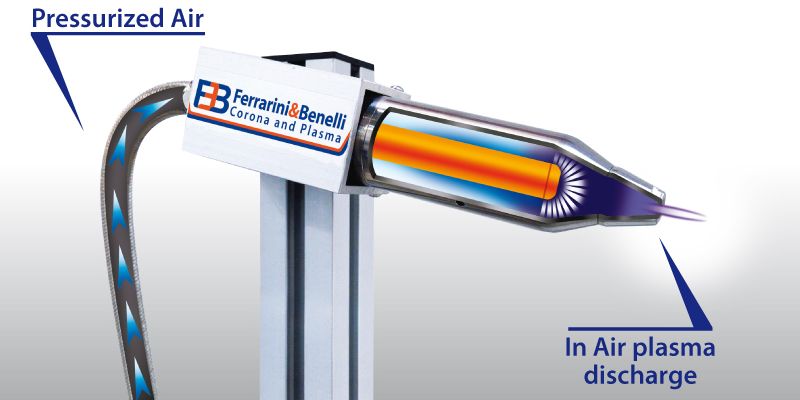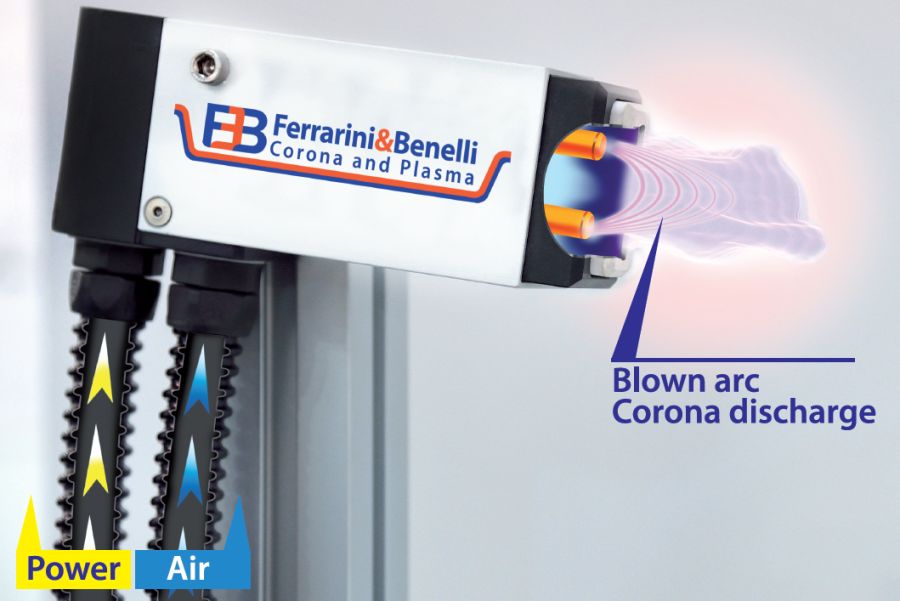Plasma can be defined as the 4th state of matter, after solid, liquid and gas. Administering energy to a gaseous matter, through an electric discharge, the gas turns into plasma.
This principle of physics is the basis of the plasma treatment that, by striking the surface to be treated via nozzles, changes the surface energy.

Hot plasma, around a thousand degrees, is used in the metal and ceramics industry. Cold plasma is useful for processing very delicate materials such as plastic, paper and integrated circuits.
Three types of plasma treatments exist:
- atmospheric pressure (the most innovative and economical)
- low pressure (vacuum) which needs separate chamber and evacuation pump
- high pressure (unsuitable for surface treatments)
Plasma generated at normal atmospheric pressure can be integrated in-line and results in better adhesion and resistance of the treated surfaces. It promotes the application of inks, paints, adhesives and coatings, eliminating release agents and additives, confers greater resistance to corrosive agents....
Advantages of atmospheric pressure plasma
- Ability to create functional surfaces with limited investment
- Fully compatible with robotic applications: it can easily be integrated into new lines or existing ones
- High level of reliability, processing speed, pinpoint accuracy and reduced energy consumption
- Degree of activation of the surfaces superior to corona treatment
- Green Technology: plasma pre-treatment does not use solvents (which are used in wet electrochemical processes) and allows the application of water based paints and adhesives
- Moreover, unlike the corona treatment, plasma treatment produces no ozone
- Potential-free discharge: treated materials are not subjected to any electrical voltage.
How the plasma treatment works
In Air Plasma
Plasma is created inside the nozzle between two electrodes. Then, it is directed toward the substrate that needs to be treated by an air flow. One or more nozzles are linked to the generator through a screened cable with a pressure gauge.
Treatment width of the dedicated nozzle is 10 mm.
Surface modification can be adjusted by varying the input power, modulation frequency of the electric field, nature and pressure of the supply gas, the temperature and the position of the substrate.

In Air Plasma Spark
The digital generator brings the plasma to excitation and the nozzles deliver and spread the discharge towards the material that has to be treated through an airflow. (Compressed air is not necessary).
Treatment width of the dedicated nozzle is 40 mm.

Examples of plasma treatment application
Many industries today resort to plasma treatment at atmospheric pressure to increase the wettability, adhesion and printability of the surfaces and to add new properties to conventional materials (hardness, scratch resistance and corrosion resistance, water/oil repulsion ...).
Packaging
To treat small areas of aluminium foil and plastic, to promote adhesion of glues used in the production of plastic boxes (fold-and-glue lines); prepare the boxes for subsequent phases of production (gluing, printing, foiling); to improve the adhesion of printing inks, coatings and paints even on difficult surfaces.
Transport
To treat dashboards, bumpers, improve the anchoring of motor vehicle door seals, improve structural bonding and painting of motorcycle and truck parts, to give the surface anti corrosion properties.
Electronic
To prepare displays for scratch resistant treatment; optimize the production of semiconductors; paint mobile telephone casings without using volatile organic compounds (VOCs).
Consumer goods
To coat profiles and seal the edges of panels for furniture; optimize bonding of appliance parts, paint plastic toys using non-toxic colors.